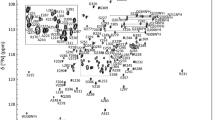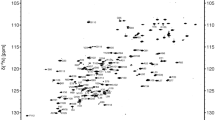Abstract
Death receptors (DR) selectively drive cancer cells to apoptosis upon binding to the Tumor necrosis factor-a-Related Apoptosis-Inducing Ligand (TRAIL). Complex formation induces the oligomerization of the death receptors DR4 (TRAIL-R1) and DR5 (TRAIL-R2) and transduces the apoptogenic signal to their respective death domains, leading to Death Inducing Signaling Complex (DISC) formation, caspase activation and ultimately cell death. Several crystal structures of the ExtraCellular Domain from Death Receptor 5 (DR5-ECD) have been reported in complex with the TRAIL ligand or anti-DR5 antibodies, but none for the isolated protein. In order to fill this gap and to perform binding experiments with TRAIL peptidomimetics, we have produced isotopically labelled DR5-ECD and started a conformational analysis by using high-field 3D NMR spectroscopy. Herein, we present the first resonance assignment of a TRAIL receptor in solution and the determination of its secondary structure from NMR chemical shifts.



Similar content being viewed by others
Abbreviations
- DR5:
-
Death receptor 5
- TRAIL:
-
Tumor necrosis factor-a-Related Apoptosis-Inducing Ligand
- ECD:
-
Extra cellular domain
- HSQC:
-
Heteronuclear single quantum coherence transfer
References
Adams C, Totpal K, Lawrence D, Marsters S, Pitti R, Yee S, Ross S, Deforge L, Koeppen H, Sagolla M, Compaan D, Lowman H, Hymowitz S, Ashkenazi A (2008) Structural and functional analysis of the interaction between the agonistic monoclonal antibody Apomab and the proapoptotic receptor DR5. Cell Death Differ 15(5):751–761
Ashkenazi A, Dixit VM (1998) Death receptors: signaling and modulation. Science 281(5381):1305–1308
Beyrath J, Chekkat N, Smulski CR, Lombardo CM, Lechner MC, Seguin C, Decossas M, Spanedda MV, Frisch B, Guichard G, Fournel S (2016) Synthetic ligands of death receptor 5 display a cell-selective agonistic effect at different oligomerization levels. Oncotarget 7(40):64942–64956
Cha SS, Sung BJ, Kim YA, Song YL, Kim HJ, Kim S, Lee MS, Oh BH (2000) Crystal structure of TRAIL-DR5 complex identifies a critical role of the unique frame insertion in conferring recognition specificity. J Biol Chem 275(40):31171–31177
Delaglio F, Grzesiek S, Vuister GW, Zhu G, Pfeifer J, Bax A (1995) NMRPipe: a multidimensional spectral processing system based on UNIX pipes. J Biomol NMR 6(3):277–293
Fellouse FA, Li B, Compaan DM, Peden AA, Hymowitz SG, Sidhu SS (2005) Molecular recognition by a binary code. J Mol Biol 348(5):1153–1162
Graves JD, Kordich JJ, Huang TH, Piasecki J, Bush TL, Sullivan T, Foltz IN, Chang W, Douangpanya H, Dang T, O’Neill JW, Mallari R, Zhao X, Branstetter DG, Rossi JM, Long AM, Huang X, Holland PM (2014) Apo2L/TRAIL and the death receptor 5 agonist antibody AMG 655 cooperate to promote receptor clustering and antitumor activity. Cancer Cell 26(2):177–189
Hymowitz SG, Christinger HW, Fuh G, Ultsch M, O’Connell M, Kelley RF, Ashkenazi A, de Vos AM (1999) Triggering cell death: the crystal structure of Apo2L/TRAIL in a complex with death receptor 5. Mol Cell 4(4):563–571
Li B, Russell SJ, Compaan DM, Totpal K, Marsters SA, Ashkenazi A, Cochran AG, Hymowitz SG, Sidhu SS (2006) Activation of the proapoptotic death receptor DR5 by oligomeric peptide and antiobody agonists. J Mol Biol 361(3):522–536
MacFarlane M, Ahmad M, Srinivasula SM, Fernandes-Alnemri T, Cohen GM, Alnemri ES (1997) Identification and molecular cloning of two novel receptors for the cytotoxic ligand TRAIL. J Biol Chem 272(41):25417–25420
Mérino D, Lalaoui N, Morizot A, Solary E, Micheau O (2007) TRAIL in cancer therapy: present and future challenges. Expert Opin Ther Targets 11(10):1234–1299
Mongkolsapaya J, Grimes JM, Chen N, Xu XN, Stuart DI, Jones EY, Screaton GR (1999) Structure of the TRAIL-DR5 complex reveals mechanisms conferring specificity in apoptotic initiation. Nat Struct Biol 6(11):1048–1053
Nemčovičová I, Benedict CA, Zajonc DM (2013) Structure of human cytomegalovirus UL141 binding to TRAIL-R2 reveals novel, non-canonical death receptor interactions. PLoS Pathog 9(3):e1003224
Newsom-Davis T, Prieske S, Walczak H (2009) Is TRAIL the holy grail of cancer therapy? Apoptosis 14(4):607–623
Pavet V, Beyrath J, Pardin C, Morizot A, Lechner MC, Briand JP, Wendland M, Maison W, Fournel S, Micheau O, Guichard G, Gronemeyer H (2010) Multivalent DR5 peptides activate the TRAIL death pathway and exert tumoricidal activity. Cancer Res 70(3):1101–1110
Pulka-Ziach K, Pavet V, Chekkat N, Estieu-Gionnet K, Rohac R, Lechner MC, Smulski CR, Zeder-Lutz G, Altschuh D, Gronemeyer H, Fournel S, Odaert B, Guichard G (2015) Thioether analogues of disulfide-bridged cyclic peptides targeting death receptor 5: conformational analysis, dimerisation and consequences for receptor activation. Chembiochem 16(2):293–301
Sattler M, Schleucher J, Griesinger C (1999) Heteronuclear multidimensional NMR experiments for the structure determination of proteins in solution employing pulsed field gradients. Prog NMR Magn Reson Spectrosc 34:93–158
Skinner SP, Fogh RH, Boucher W, Ragan TJ, Mureddu LG, Vuister GW (2016) CcpNmr analysis assign: a flexible platform for integrated NMR analysis. J Biomol NMR 66:111–124
Takeda K, Stagg J, Yagita H, Okumura K, Smyth MJ (2007) Targeting death-inducing receptors in cancer therapy. Oncogene 26(25):3745–3757
Tamada T, Shinmi D, Ikeda M, Yonezawa Y, Kataoka S, Kuroki R, Mori E, Motoki K (2015) TRAIL-R2 superoligomerization induced by human monoclobal agonistic antibody KMTR2. Sci Rep 5:17936
Walczak H, Degli-Esposti MA, Johnson RS, Smolak PJ, Waugh JY, Boiani N, Timour MS, Gerhart MJ, Schooley KA, Smith CA, Goodwin RG, Rauch CT (1997) TRAIL-R2: a novel apoptosis-mediating receptor for TRAIL. EMBO J 16(17):5386–5387
Wang Y, Jardetzky O (2002) Probability-based protein secondary structure identification using combined NMR chemical-shift data. Protein Sci 11(4):852–861
Wishart DS, Bigam CG, Yao J, Abildgaard F, Dyson HJ, Oldfield E, Markley JL, Sykes BD (1995) 1H, 13C and 15N chemical shift referencing in biomolecular NMR. J Biomol NMR 6:135–140
Yang S, Bax A (2013) TALOS-N: protein backbone and sidechain torsion angles predicted from NMR chemical shifts using artificial neural networks. J Biomol NMR 56:227–241
Acknowledgements
We thank the structural biology platform at the Institut Européen de Chimie et Biologie (UMS 3033) for access to NMR spectrometers and technical assistance. Antoine Baudin was supported by a French PhD fellowship afforded to the University of Bordeaux by the Ministère de la Recherche (MNERT) and a fourth year PhD extension by the Ligue nationale Contre le Cancer (LCC). The project was funded by the Ligue Contre le Cancer de la Gironde. We thank Dr Yong-Sung Kim from the Ajou University of the Republic of Korea for providing us the plasmid containing the gene coding for DR5-ECD. AL and MB acknowledge the H2020 program (ERC-2015-StG GA no. 639020).
Author information
Authors and Affiliations
Corresponding author
Rights and permissions
About this article
Cite this article
Baudin, A., Guichard, A., Collie, G.W. et al. 1H, 13C, 15N NMR resonance assignments and secondary structure determination of the extra-cellular domain from the human proapoptotic TRAIL-R2 death receptor 5 (DR5-ECD). Biomol NMR Assign 12, 309–314 (2018). https://doi.org/10.1007/s12104-018-9828-1
Received:
Accepted:
Published:
Issue Date:
DOI: https://doi.org/10.1007/s12104-018-9828-1




